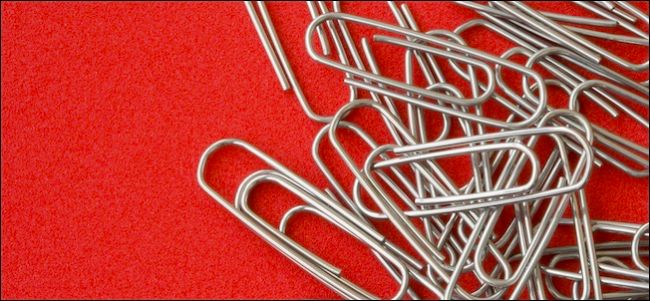
There comes a time, job-hunting, or sharing photos?with older family members,?where?you?may need?to send stuff the old fashioned way – as an email attachment. If you email at work, it may be a part of your email repertoire.
有時需要找工作,與年長的家庭成員分享照片或與他們共享照片,在這種情況下,您可能需要以老式的方式發送內容(作為電子郵件附件)。 如果您在工作時通過電子郵件發送郵件,則可能是您的電子郵件清單中的一部分。
The thing about attachments is, there’s a sort of unwritten code with regard to sending them. For example, while you could send a huge file in an e-mail (it depends on how much the service or ISP you’re using will allow), it’s not necessarily efficient. Similarly, sending multiple files is usually better accomplished zipped in a container file.
關于附件的事情是,關于附件的發送有一種未編寫的代碼。 例如,雖然您可以在電子郵件中發送一個巨大的文件(取決于您所使用的服務或ISP允許的數量),但這不一定有效。 同樣,發送多個文件通常可以更好地壓縮到容器文件中。
Of course, depending on the kind of file it is, it may or may not arrive at its destination. Files such as those ending in .EXE, .BAT, and other executable types, will often (usually) be blocked or stripped because of their association with malware. If you want to send a file like this, you’ll probably need to enclose it in a .ZIP archive.
當然,取決于文件的類型,它可能會到達也可能不會到達目的地。 以.EXE,.BAT和其他可執行文件類型結尾的文件,由于與惡意軟件的關聯,通常(通常)被阻止或剝離。 如果要發送這樣的文件,則可能需要將其包含在.ZIP存檔中。
Composing an e-mail and managing contacts in Outlook is pretty simple, and while adding and handling attachments should be second nature by now, a lot of user may not realize that they could be doing it better.
在Outlook中編寫電子郵件和管理聯系人非常簡單,雖然現在添加和處理附件已經是第二天性,但許多用戶可能還沒有意識到他們可以做得更好。
添加附件 (Adding an Attachment)
To add an attachment, you can drag a file or files to a?blank email message, and it will be pasted as an attachment. Or, click the “Attach File” button on the ribbon, in the Include section.
要添加附件,您可以將一個或多個文件拖到空白電子郵件中,并將其粘貼為附件。 或者,單擊功能區上“包含”部分中的“附加文件”按鈕。

You’ll need to browse to the location where the file you want to attach is located and then select the file or files you want to include in your message, then click “Insert.” Alternatively, click the small arrow and select “Insert as Text” and your attachment will be inserted inline, meaning it will appear in?your message instead of as separate file.
您需要瀏覽到要附加的文件所在的位置,然后選擇要包含在郵件中的一個或多個文件,然后單擊“插入”。 或者,單擊小箭頭,然后選擇“以文本形式插入”,您的附件將被插入行內,這意味著它會出現在您的消息中,而不是作為單獨的文件出現。
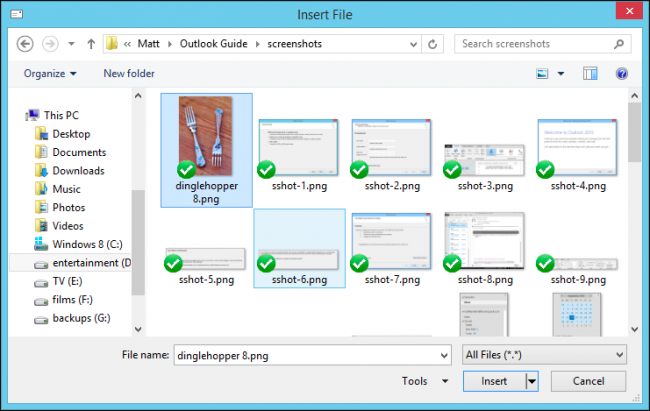
Once attached, you’ll be able to see it?in the Attached field beneath the Subject line.
附加后,您將可以在“主題”行下方的“附加”字段中看到它。
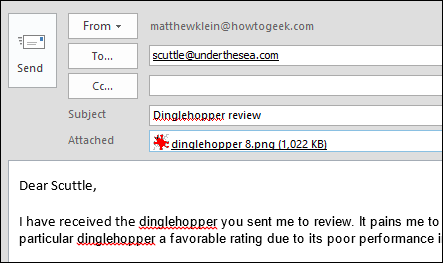
Finally, let’s say you’ve got your attachment attached, and you realize it’s the wrong one. No problem, you can simply select the attachment hit the “Delete” button on your keyboard, or you can right-click and select “Remove.”
最后,假設您已附加附件,但您意識到附件是錯誤的。 沒問題,您可以選擇附件并點擊鍵盤上的“刪除”按鈕,也可以右鍵單擊并選擇“刪除”。
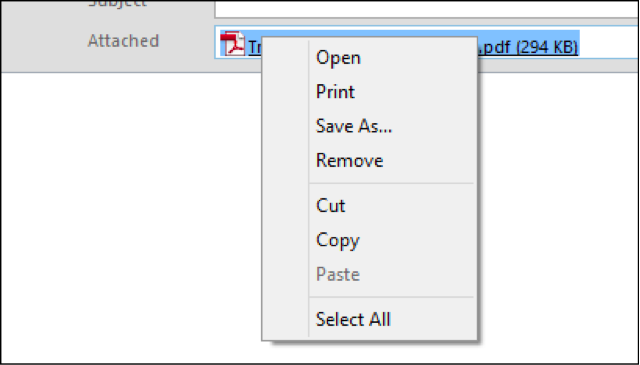
Files aren’t the only thing you can attach to message though, you can also attach items and signatures.
文件不是您唯一可以附加到郵件上的東西,還可以附加項目和簽名。
附加其他東西 (Attaching?Other Stuff)
Items can include business cards (.VCF files, discussed earlier), calendars, and Outlook items, which can be notes, tasks, contacts, and other stuff that you open in Outlook.
項目可以包括名片(.VCF文件,前面已討論),日歷和Outlook項目,它們可以是便箋,任務,聯系人以及您在Outlook中打開的其他內容。
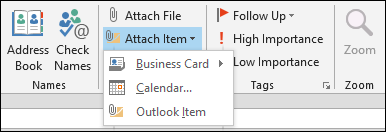
Calendars are another thing you’ll possibly want to share from time to time, and if you click on the “Attach Item” button, you’ll see it’s easy to do just that. Sharing your calendar doesn’t mean you have to share every single item on every single day. You may just want to share a few days or a week, such as for a company getaway or family holiday itinerary.
日歷是您可能不希望共享的另一件事,如果您單擊“附加項目”按鈕,您會發現做到這一點很容易。 共享日歷并不意味著您必須每天共享每個項目。 您可能只想共享幾天或一周的時間,例如公司度假或家庭度假行程。
Sharing a calendar will give you options to choose the actual calendar, the date range, details, and other advanced options.
共享日歷將為您提供選擇實際日歷,日期范圍,詳細信息和其他高級選項的選項。

When you click “OK,” you will then see that the calendar will be attached to the email message so it can be opened and viewed, but it will also be pasted into the actual message so recipients can conveniently view it at a glance.
當您單擊“確定”時,您將看到該日歷將附加到電子郵件中,以便可以打開和查看它,但也將其粘貼到實際的消息中,以便收件人可以方便地一目了然。
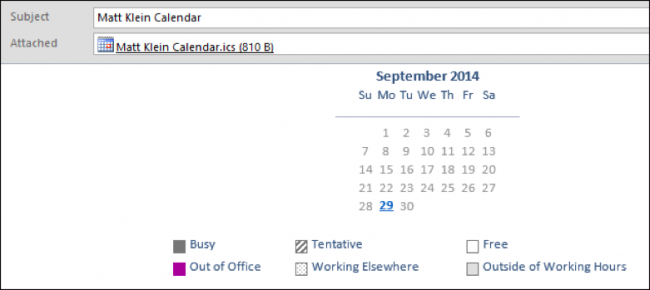
Outlook items are basically anything you can create in Outlook, which can then be attached and sent to other Outlook users. In the following screenshot, you see how this works. You pick the source and then from there, choose the item or items (you can choose more than one) you want to attach.
Outlook項目基本上是您可以在Outlook中創建的任何內容,然后可以將其附加并發送給其他Outlook用戶。 在以下屏幕截圖中,您將看到它是如何工作的。 您選擇來源,然后從那里選擇要附加的一個或多個項目(可以選擇多個)。
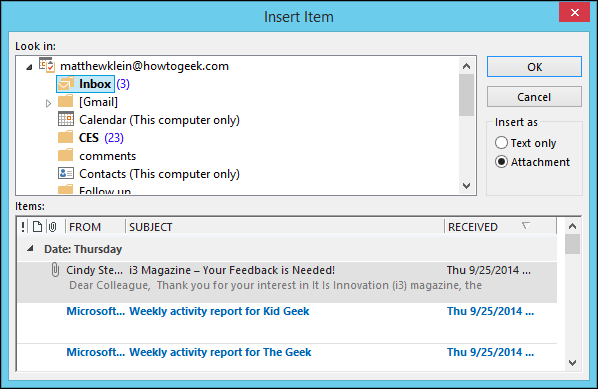
Note, you can decide if you want the item to arrive as an actual physical attachment or inline as text only. This is the same as we discussed earlier where you can “Insert as Text” and it will appear as part of the physical message.
請注意,您可以決定是要以實際的物理附件形式還是以文本形式直接插入項目。 這與我們之前討論的相同,您可以在其中“以文本形式插入”,并且它將作為物理消息的一部分出現。
Business cards may or may not be one of those things you use or need, but it’s a really convenient way to share your immediate details in a simple, convenient package. If you want to share your (or anyone else’s) business card, you simply choose it from the Attach Item menu and your contacts will appear
名片可能不是您使用或需要的東西之一,但這是在一個簡單便捷的程序包中共享您的即時詳細信息的非常便捷的方法。 如果要共享您(或其他任何人)的名片,只需從“附加項目”菜單中選擇它,您的聯系人就會出現
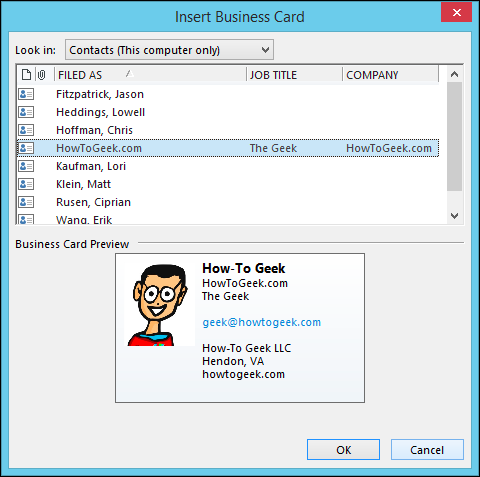
Choose the card or cards you want to attach and click “OK” and the cards will appear as text and will also be attached as a .VCF file, which means it can be imported into any address book that support such files.
選擇您要附加的卡,然后單擊“確定”,這些卡將顯示為文本,也將附加為.VCF文件,這意味著可以將其導入支持該文件的任何通訊簿中。

Sharing contacts as business cards is a really quick and convenient way to supply someone else with contact information, or to import contact information from someone else without having to type it into your address book by hand.
將名片共享為聯系人是一種非常快速便捷的方法,可以向其他人提供聯系信息,或從其他人導入聯系信息,而無需手動將其輸入到您的通訊錄中。
處理附件 (Handling Attachments)
Of course, with email, there’s always the opportunity to receive as well as give. So, what do you do when a message with attachments arrives in your inbox? Usually it’s pretty straightforward, such as in the following image. You see our test message has arrived with an image attached.
當然,有了電子郵件,總有機會獲得和給予。 因此,當帶有附件的郵件到達收件箱時,您該怎么辦? 通常,它非常簡單明了,如下圖所示。 您會看到我們的測試消息已附帶圖像。
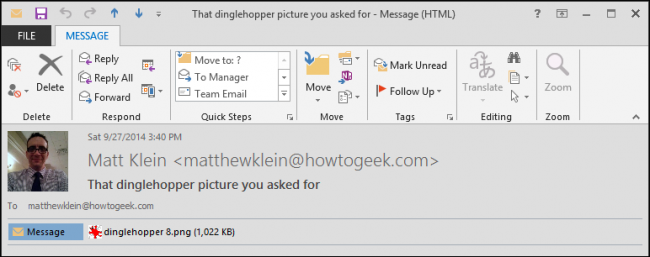
If we simply click on the attachment, you see that options appear in the Ribbon call Attachment Tools. From here you can take action on it. Notice also that if you receive multiple files, you can save all your attachments at once and if you’re unsure about whether it’s wise to open the attachment at all, then you can remove it, though it’s probably wiser to simply delete the message if you have doubts.
如果我們僅單擊附件,就會看到功能區調用附件工具中顯示了選項。 從這里您可以對此采取行動。 還要注意,如果收到多個文件,則可以一次保存所有附件,如果不確定完全打開附件是否明智,則可以將其刪除,盡管如果有以下情況,可以簡單地刪除郵件:你有疑問。
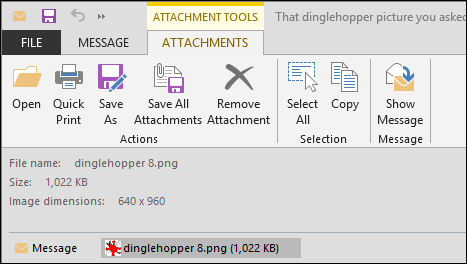
You can also right-click on any attachment in a message and you can use the resulting drop-down menu to take the same actions as found on the Ribbon.
您也可以右鍵單擊郵件中的任何附件,然后使用出現的下拉菜單執行與功能區上相同的操作。
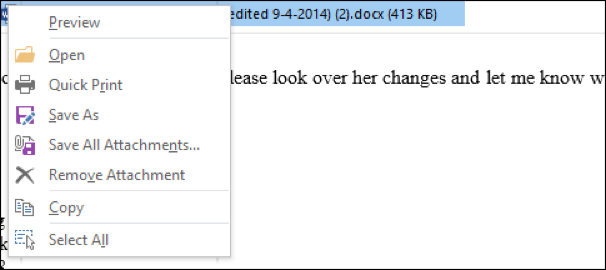
When handling attachments, caveats abound. Attachments can be dangerous as anyone who has used email in the past twenty years can attest. Bottom line, don’t open anything that isn’t from anyone you do not know or trust, and always use a virus/malware scanner on your computer.
處理附件時,注意事項很多。 附件可能很危險,因為過去二十年來使用電子郵件的任何人都可以證明。 最重要的是,請勿打開任何您不認識或不信任的人的東西,并始終在計算機上使用病毒/惡意軟件掃描程序。
將多個文件或大文件作為附件處理 (Handling Multiple Files or Large Files as Attachments)
We talked a bit about how to handle one or maybe a few attachments, but what if you want to attach dozens or even hundreds of files? Or, what if you want to attach a large file?
我們討論了如何處理一個或幾個附件,但是如果要附加幾十個甚至數百個文件怎么辦? 或者,如果您要附加大文件怎么辦?
Sending large attachments is kind of uncool, especially if someone gets a lot of email in the process. The problem with sending large files over email isn’t so much whether or not you mail server will allow attachments over certain size. For the most part, you probably won’t send a file much larger than a megabyte or two, or at least you shouldn’t.
發送大型附件有點不爽,尤其是在此過程中有人收到很多電子郵件的情況下。 通過電子郵件發送大文件的問題不是郵件服務器是否允許特定大小的附件。 在大多數情況下,您可能不會發送比一兆字節大得多的文件,或者至少您不應該發送。
Nevertheless, there’s gonna be those times where you need to send something that’s a little unwieldy. If you use a webmail service like Yahoo, Gmail, or Microsoft, then they’ll have size limits (25Mb, 25Mb, 20Mb, respectively), just as your ISP, e.g. Comcast, Time Warner, AT&T, etc. will as well (usually about 10 Mb).
但是,在某些情況下,您需要發送有些笨拙的郵件。 如果您使用Yahoo,Gmail或Microsoft之類的網絡郵件服務,則它們將具有大小限制(分別為25Mb,25Mb,20Mb),就像您的ISP(例如Comcast,Time Warner,AT&T等)一樣(通常大約10 Mb)。
In most cases, when files are excessively large or numerous, we defer to using a cloud service, which are plentiful and offer enough free space to send the vast majority of files. More often than not, simply uploading your files to a cloud drive and then sharing it, is faster and more reliable than email.?We’ve a handy how-to that explains exactly how to send large files over e-mail?in case you would like to learn more.
在大多數情況下,當文件過大或過多時,我們會選擇使用云服務,因為云服務足夠多并提供足夠的可用空間來發送絕大多數文件。 通常,僅將文件上傳到云驅動器然后進行共享,通常比電子郵件更快,更可靠。 我們有一個方便的操作方法,它準確地解釋了如何在您想了解更多信息的情況下通過電子郵件發送大文件。
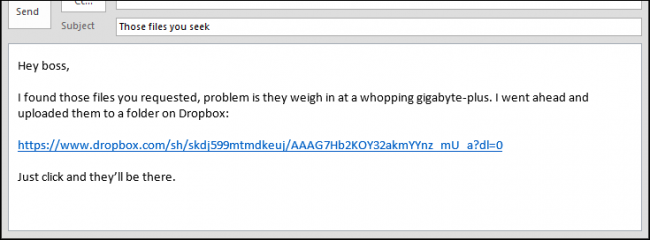
As far as sending multiple files are concerned, you shouldn’t have a problem provided it’s a few but once you start attaching dozens of pictures or documents, things can get a little awkward. Again, consider using a cloud service. Regardless, we suggest you definitely zip multiple files before sending them off. Windows has native support for zip files so you needn’t worry about your recipient not being able to open it.
就發送多個文件而言,只要有幾個文件就不會有問題,但是一旦開始附加許多圖片或文檔,事情就會有些尷尬。 同樣,請考慮使用云服務。 無論如何,我們建議您在發送多個文件之前絕對將其壓縮。 Windows對zip文件具有本機支持,因此您不必擔心收件人無法打開它。
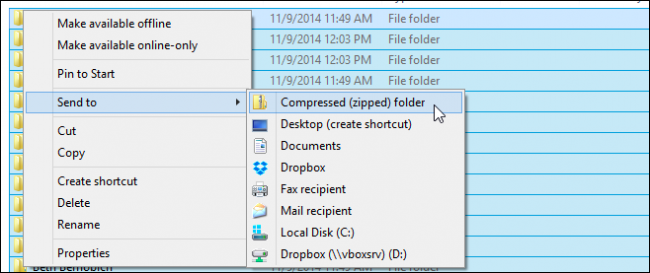
Please check out this article,?which explain everything you need to know about zipped files.
請查看這篇文章,其中介紹了您需要了解的有關壓縮文件的所有信息。
This seems like a pretty good place to end our discussion of attachments. They’re not a complicated subject, but regardless of whether you use Outlook, or Gmail, or any other email, sending files?may require a few extra?steps beyond simply attaching them.
這似乎是結束我們對附件的討論的一個不錯的地方。 它們不是一個復雜的主題,但是無論您使用的是Outlook,Gmail還是任何其他電子郵件,發送文件都可能需要一些額外的步驟,而不僅僅是附加它們。
As to now, we’ve covered the most basic parts of the Outlook’s email powers – contacts, addressing, composing – all of which, are pretty simple stuff. Now with attachments, you have a fairly well-rounded knowledge?of the simple things.
到目前為止,我們已經介紹了Outlook電子郵件功能的最基本部分-聯系人,地址,撰寫-所有這些都是非常簡單的內容。 現在有了附件,您對簡單的東西有了相當全面的了解。
Now, it’s time to step up our game. As you use Outlook and accumulate email, you’ll need to learn how to manage it using tools like Quick Steps and rules, which we’ll talk about in an upcoming feature.?In the meantime, and as always, we encourage you to give us your feedback in our discussion forum.
現在,是時候加強我們的游戲了。 使用Outlook和累積電子郵件時,您將需要學習如何使用“快速步驟”和規則之類的工具進行管理,我們將在即將發布的功能中對其進行討論。 同時,我們一如既往地鼓勵您在我們的論壇中向我們提供反饋。
翻譯自: https://www.howtogeek.com/203241/beginner-how-to-manage-attachments-in-outlook-2013/









)

 - UART寄存器)




)
)

